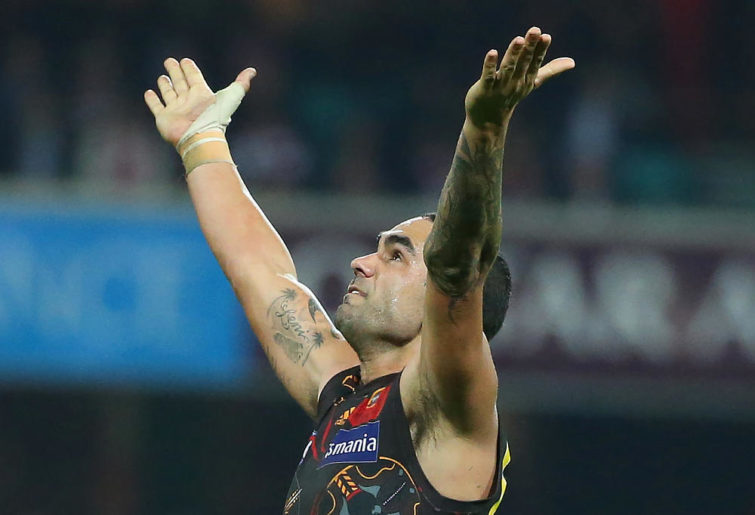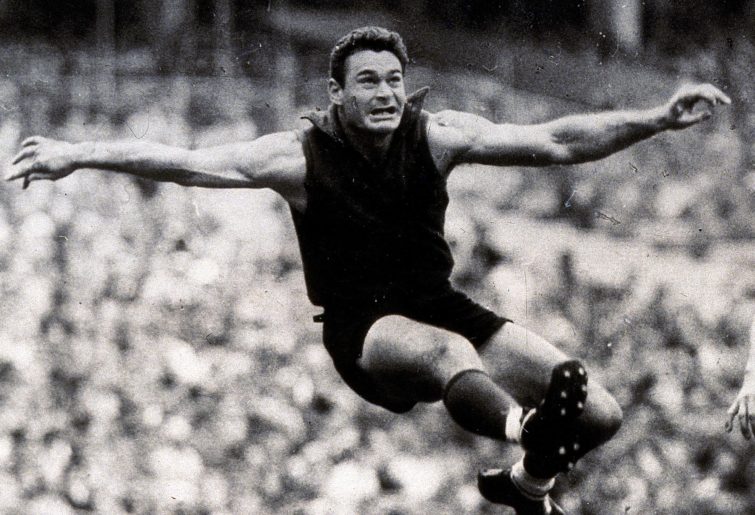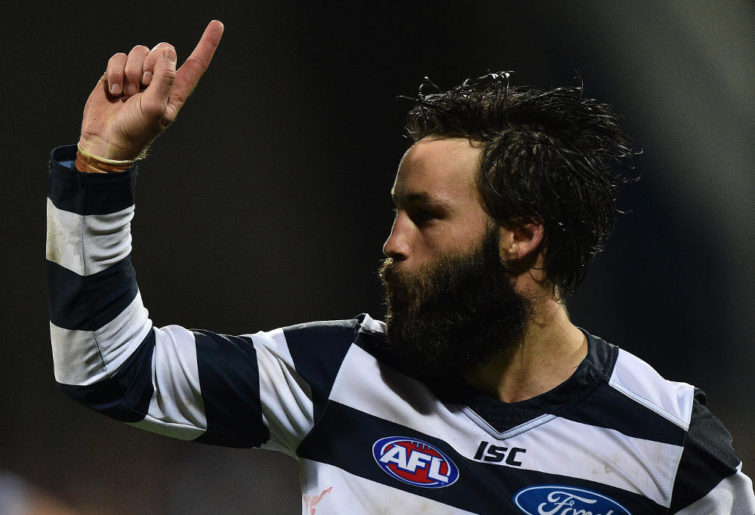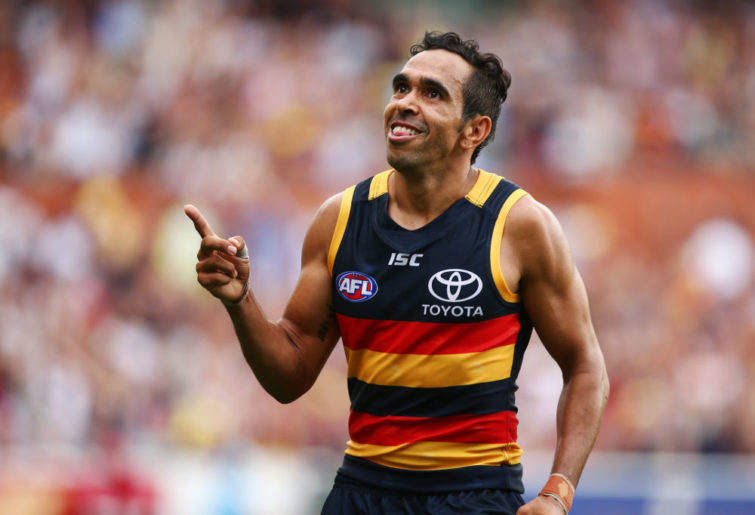After the A team, we move now to B, a team stretching from almost all the way back to the inception of the VFL to today.
Back line
Martin Bolger (Richmond 1930-39)
185 games, two goals
Throughout the 1930s Martin Bolger was one of the lynchpins of Richmond’s defence, minding the opposing team’s resting rovers to nullify their impact. His skill was such that he could have played as a rover himself, but for the benefit of the team he stayed back. Bolger starred in Richmond’s 1932 and 1934 premierships and won a club best and fairest in 1936.
Fred Baring (Essendon 1910-24)
154 games, 92 goals
In the early part of his career Fred Baring was part of a famous combination for the Same Olds, combining with Ernie Cameron to form a deadly ruck-rover duo. Indeed it was as a ruckman that he kicked the sealing goal in the 1912 grand final. After World War I Baring settled into a new position at fullback and starred in the club’s 1923 and 1924 flags to make him a four-time premiership winner. Named fullback in Essendon’s team of the century, he was also chosen as No. 24 in a list of 25 champions of Essendon in 2002.
Nathan Burke (St Kilda 1987-2003)
323 games, 124 goals
Burke was an ever-present member of the St Kilda side throughout the 1990s, throwing himself into packs and leading the club by example as they rose to a grand final appearance in 1997. Tough, resilient and skilled, Burke won three club best and fairest medals and represented Victoria 11 times in his career. By the time he retired he was the Saints games record holder. Interestingly, he was named in the forward pocket of St Kilda’s team of the century, but given his work rate and accountability I have selected him in the back pocket here.
Halfback line
Trevor Barker (St Kilda 1975-89)
230 games, 134 goals
A St Kilda game in the 1980s just wouldn’t have been complete without Trevor Barker throwing his body around in places it had no right to go or taking some of the most spectacular marks of the decade. Barker was a universally popular player who represented Victoria seven times and won two club best and fairests, but he never had team success, playing the most matches without a single final. Sadly, cancer claimed his life far too early, but he was immortalised by having the best and fairest named after him as well as being on a halfback flank in St Kilda’s team of the century.
Bill Busbridge (Essendon 1904-12)
103 games, 32 goals
‘Bussy’ was one of the first superstars of Essendon, starring as a centre halfback and occasional ruckman. Busbridge won club best and fairest medals in 1908-09 and in the latter year was recognised by readers of the Argus newspaper as the champion of the colony, a precursor to the Brownlow. Busbridge played in the club’s 1911 flag before retiring due to a knee injury in 1912 and missing that year’s premiership. Busbridge is another of the 25 champions of Essendon, being named at No. 14. I gave him the nod over another Essendon centre halfback in Wally Buttsworth, who was named at No. 12 in that same list, in recognition of the era in which he played and the champion award, something Buttsworth never achieved, although he was named at centre halfback in the team of the century.
Shaun Burgoyne (Port Adelaide 2002-09, Hawthorn 2010-)
377 games, 293 goals
The longest-serving player still on a list in 2020, Burgoyne started at Port along the forward line before pushing back to the midfield and halfback. Consistently excelling if not getting the individual accolades, Burgoyne’s 2009 was interrupted by injury, which contributed to his being traded to Hawthorn at the end of the year. Since then, he has cemented his reputation as a tough and skilled operator and a vital part of four premiership teams.

Shaun Burgoyne (AAP Image/David Moir)
Centre line
Craig Bradley (Carlton 1986-2002)
375 games, 247 goals
Including his time in the SANFL and interstate matches, Craig Bradley played almost 500 senior games of football before finally hanging up the boots. For two decades there was Braddles running down the wing and delivering with precision to his forwards. There was Braddles kicking an important goal. There was Braddles getting three Brownlow votes in his last game and retiring as Carlton’s games record holder. Bradley also holds the record for most State of Origin matches for South Australia and was named on the wing of Carlton’s team of the century.
Nathan Buckley (Brisbane 1993, Collingwood 1994-2007)
280 games, 284 goals
Leaving aside the controversy of Buckley’s first year at Brisbane before being traded, for almost his entire career when it came to Collingwood his name was front and centre. With impeccable kicking off either foot, Buckley was a consistent ball winner and Collingwood captain from 1999 to the end of his playing career. Six club best and fairest medals, a Brownlow and seven All Australian guernseys are just the start of his accolades. He was also named on the halfback flank of Collingwood’s team of the century.
Francis Bourke (Richmond 1967-1981)
300 games, 71 goals
Courage is the first thing that comes to mind when Francis Bourke is mentioned. Bourke played a quarter of football with a broken leg in 1971. In 1980 he was accidentally poked in the eye, but with blood streaming down his face he took an inspirational mark and goal to keep Richmond ahead. His career is much more than these moments, as he was part of one of the most influential centre lines in history, comprising Francis Bourke, Bill Barrot and Dick Clay, before moving back to centre halfback and fullback as circumstances required. Bourke was named on the wing in the AFL team of the century.

Nathan Buckley (AAP Image/Alex Murray)
Ruck
Vic Belcher (South Melbourne 1907-1920)
226 games, 62 goals
This was a very close call between Vic and his brother Alan, but I gave it to Vic in recognition of his status for almost 100 years as the only dual premiership player for South/Sydney. Belcher was known for being able to ruck all day and was prominent as a defender in the latter part of his career. He was important in South’s recovery from a deficit in the 1918 grand final, moving back into the ruck to turn the tide and win the flag at the bell. Belcher was named in the back pocket of South Melbourne’s team of the century.
Ron Barassi (Melbourne 1953-64, Carlton 1965-69)
254 games, 330 goals
Ron Barassi has probably had the most impact on the VFL/AFL of anyone to ever be involved in the game. He was destined to be a Demon, following in his father’s footsteps and being the personification of the relentless Melbourne teams of the era: fearless, skilled, determined and powerful. After his sixth flag in 1964 Barassi shocked the football world by crossing to the Blues, where he started one of the most influential coaching careers of all time. Barassi was named ruck-rover in the AFL team of the century.
Haydn Bunton (Fitzroy 1931-37, 1942)
119 games, 207 goals
Another AFL team of the century member, this time as forward pocket, Bunton was one of the most sought-after players before choosing Fitzroy to ply his trade. Scrupulously fair and incredibly skilled, Bunton won three Brownlow Medals as a rover in the space of five years. After transferring to Western Australia he won three Sandover Medals, the WAFL best and fairest equivalent, to fill his trophy cabinet further. Contemporary reports uniformly state Bunton as one of the best, if not the best, player of all time.

Ron Barassi. (Getty Images)
Half-forward line
Malcolm Blight (North Melbourne 1974-82)
178 games, 444 goals
There were things Malcolm Blight could do on a football field that no-one else would think possible. The most famous would be his 70-metre goal after the siren in 1976 to seal a win. Blight is one of only a few players to win a Brownlow (1978) and a Coleman (1982) medals in separate years.
Jonathan Brown (Brisbane 2000-14)
256 games, 594 goals
Strong, courageous and with a defter touch than would be expected from a man of his size, Jonathan Brown strode the Gabba turf as the key Lion for 15 years, winning three premierships in his first four years. His mark of the year in 2002 summed him up perfectly, running headlong into a pack and snaffling the ball. Injury dimmed his final years, but he was a feared opponent to the end.
Jimmy Bartel (Geelong 2002-16)
305 games, 202 goals
If there was a ball to put a head over, Bartel would put his head there. Taking some time to find his role in the Cats side, Bartel never looked back once he cemented his place, with a Brownlow in 2007, three flags and a Norm Smith Medal in 2011. He was an integral part of Geelong’s success and for a time was one of the most important midfielders in the game.

Jimmy Bartel (AAP Image/Julian Smith)
Forward line
Eddie Betts (Carlton 2005-13, 2020-, Adelaide 2014-19)
316 games, 600 goals
Is there a more popular footballer than Eddie Betts? From his early days at Carlton through to the Eddie Betts pocket at Adelaide he has been electric up forward, snagging goals no other player would dare attempt. A four-time goal of the year winner and one of the most enjoyable players to watch, we can only hope to see more Betts magic when footy resumes.
Simon Beasley (Footscray 1982-89)
154 games, 575 goals
Kicking the most goals of anyone in the 1980s, Simon Beasley was a full-forward with good pace on the lead and a strong mark. Winning the Coleman Medal in 1985 as the Dogs reached the preliminary final, only in his final injury-marred season did he not lead the club goal kicking. Beasley was chosen as full-forward in Footscray’s team of the century and still holds the record for most goals kicked for the club.
Kevin Bartlett (Richmond 1965-83)
403 games, 778 goals
The first man to reach 400 games, Kevin Bartlett was a rover of unrivalled skill and a great nose for goal – so much so that a Bartlett handball was worth noting more than a goal! A member of five premiership teams, his 1980 final series will live long in the memory: 21 goals in three games culminating in the Norm Smith Medal.

(Morne de Klerk/Getty Images)
Interchange
Simon Black (Brisbane 1998-2013)
322 games, 171 goals
One of Brisbane’s Fab Four midfielders, Black was a model of consistency and always found himself near the ball. Part of the Lion threepeat, he set a record in 2003 of 39 possessions on his way to a Norm Smith Medal. His induction into the hall of fame was delayed a year as he went to play Australian Survivor in 2019, ultimately finishing seventh of 24.
Percy Bentley (Richmond 1925-40)
263 games, 275 goals
A skilled ruckman who used his body well to get around the ground, Bentley is one of the longest-serving club captains in Richmond history (from 1932 to 1940, and captain-coach from 1934). Leading the club to the 1932 and 1934 flags, Bentley was also a Victorian representative on six occasions. He left Richmond due to a pay dispute and became a legendary coach for Carlton.
Percy Beames (Melbourne 1931-44)
213 games, 323 goals
Beames was a well-built rover with prodigious skill on both sides of his body. For the first part of his career Melbourne struggled, but towards the end of the 1930s the team started to rise, and a premiership hat-trick in 1939-41 saw Beames arguably the best on-field in all three grand finals. He was selected in a forward pocket in Melbourne’s team of the century. Beames was also a Victorian cricketer of note, averaging over 50 as a batsman across 18 first-class matches.
Darrel Baldock (St Kilda 1962-68)
119 games, 237 goals
A legend in the Australian Football Hall of Fame, Baldock is possibly the most revered name at St Kilda. With fantastic football nous and ball-handling skills, Baldock inspired the Saints to their first grand final in 52 years in 1965 before climbing the pinnacle for the first (and so far only) time in 1966. Early in the game Baldock had injured his thigh
Emergencies
Dermott Brereton (Hawthorn 1982-92, Sydney 1994, Collingwood 1995)
211 games, 464 goals
Dermie always had an eye for the big occasions: five goals on debut, eight goals in the 1985 grand final when the Hawks were pumped and the inspirational mark and goal in 1989 after being poleaxed by Mark Yeates all speak to his quality. Remembered as a Hawthorn legend, his low key appearances for Sydney and Collingwood still showed his flair for the dramatic.
John Blakey (Fitzroy 1985-92, North Melbourne 1993-2002)
359 games, 110 goals
For almost two decades John Blakey was a dependable member of the Fitzroy and North Melbourne teams, often playing in the midfield. Rarely did he rack up huge numbers but equally rarely did he play a bad game. Taking part in the Kangaroos’ 1996 and 1999 flags, Blakey was an emergency in North’s team of the century.
Jude Bolton (Sydney 1999-2013)
325 games, 196 goals
Jude certainly didn’t make it bad, epitomising the Bloods culture for over 300 games. A tackling machine who would stop at nothing to get the ball, Bolton played in both Swan flags of 2005 and 2012, retiring when still playing good football a year later. Although individual accolades eluded him, he was well renowned as one of the toughest players of his time.
Up next is the C team, featuring two of the greatest full-forwards of all time and two sets of famous brothers responsible for one of the greatest achievements in the history of the league.

































































































